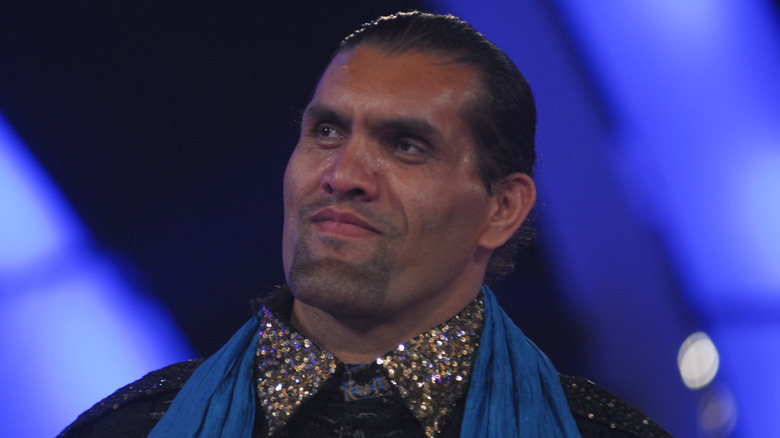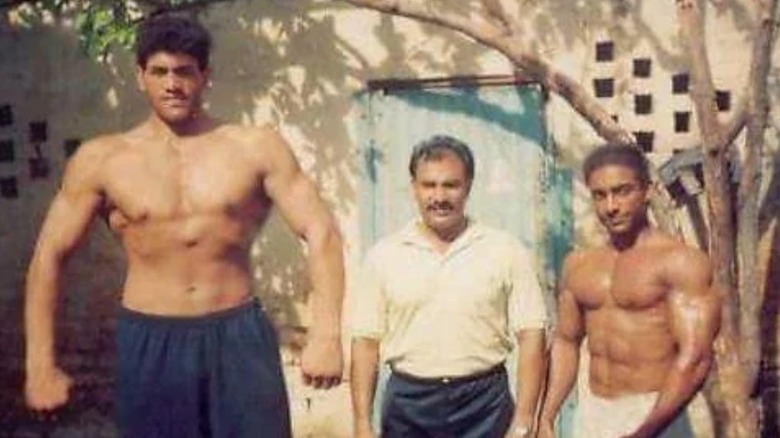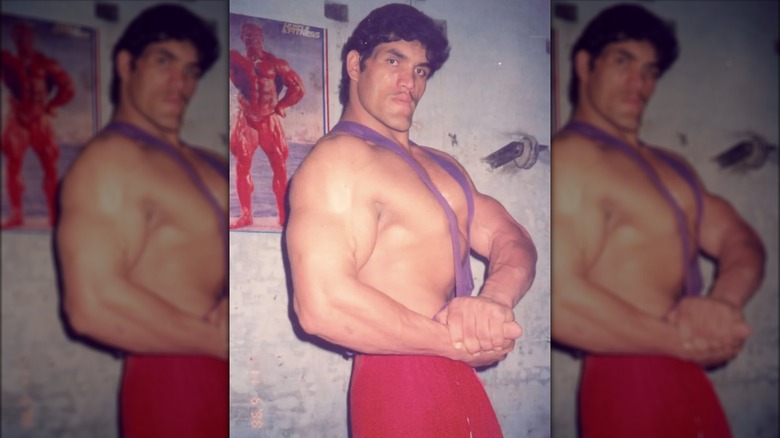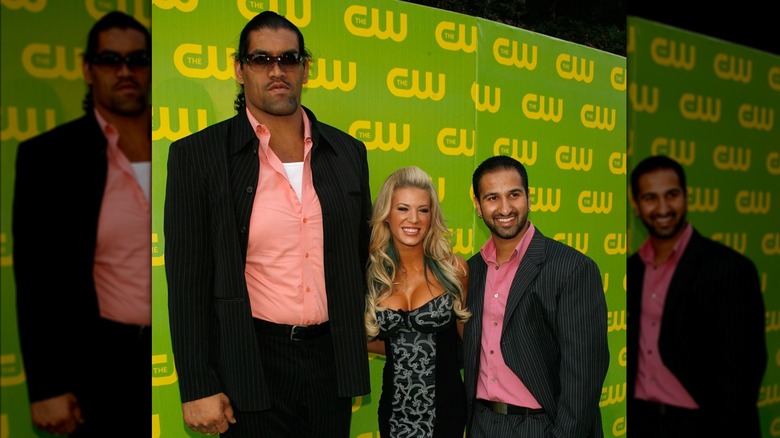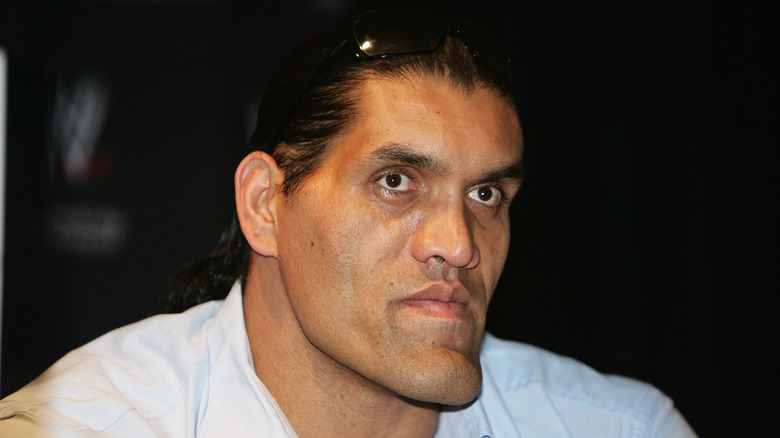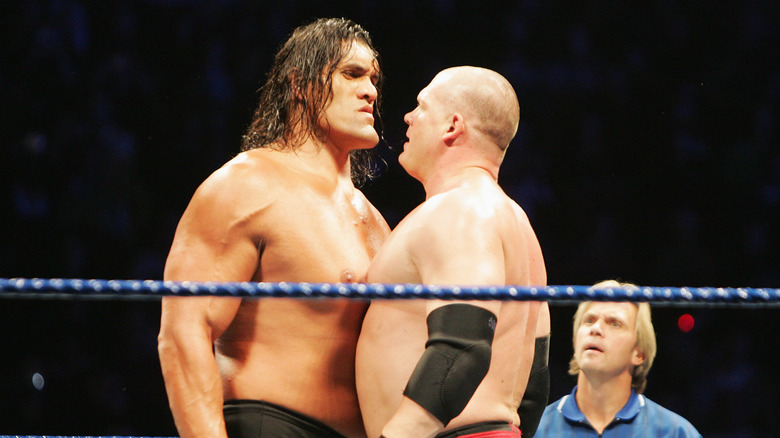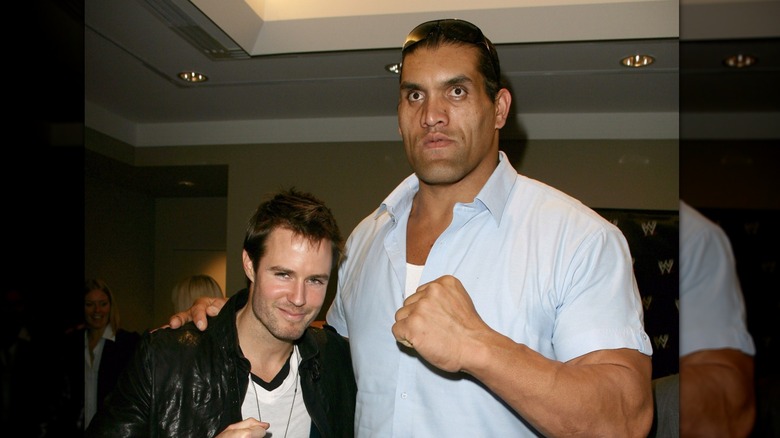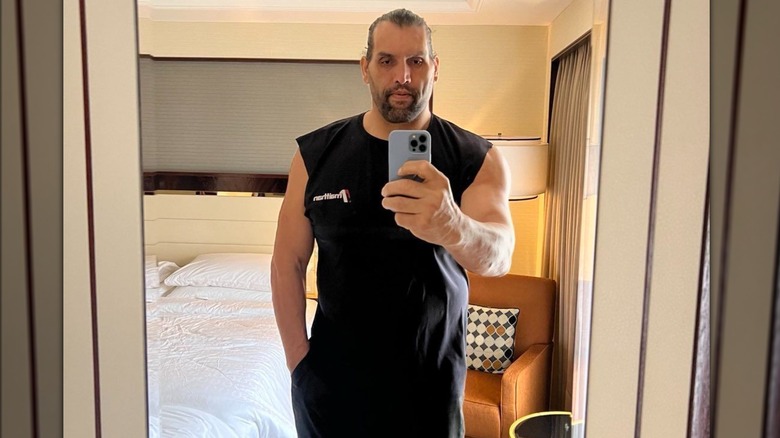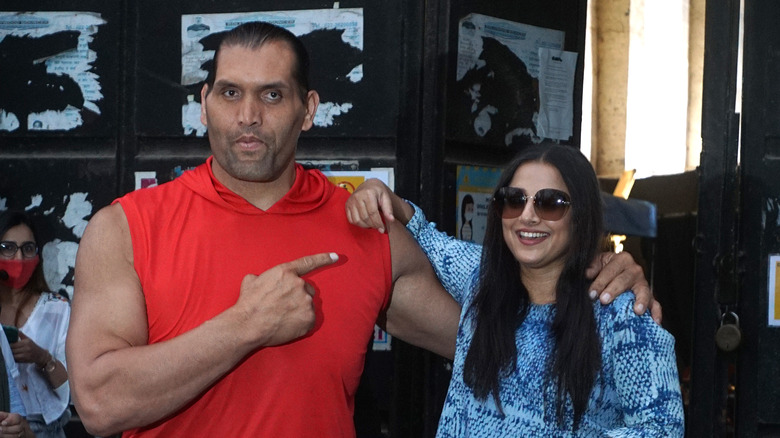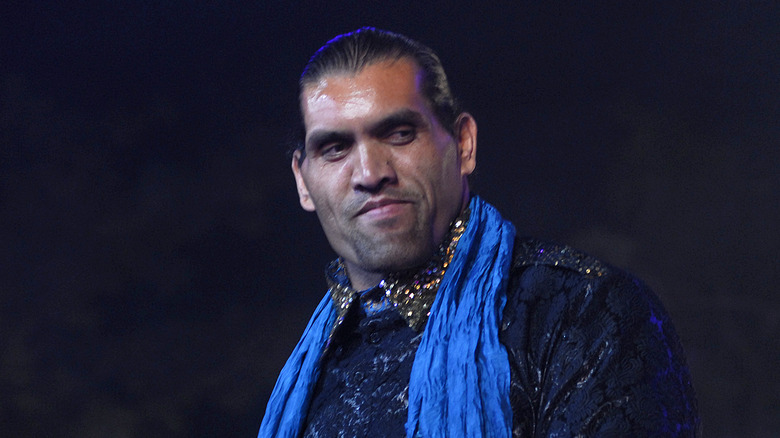The Tragic Real-Life Story Of The Great Khali
Depending on how you look at him, The Great Khali has an incredible legacy or a devastating tragedy forever tied to his name. The former professional wrestler, whose real name is Dalip Singh Rana, was a hard one to miss during his time in the WWE world, with his 7-foot-1-inch tall stature making even the most daunting of his opponents look small. But he's a polarizing character, often ridiculed and trolled for his enormous stature and how it affects his wrestling style. Because of this, fame and fortune have come with their fair share of setbacks for Rana, who had to battle the court of opinion on top of the many obstacles he overcame to become a professional wrestler.
Hailing from a poor family in India, Rana started blazing a trail for himself after defeating the hardcore wrestling legend The Undertaker in 2006. He has gone head-to-head with WWE superstars across the board, taking home victories in his bouts with Kane, Shawn Michaels, and Ric Flair throughout his career. The Great Khali ultimately put his country on the map in the wrestling universe, becoming the first Indian man to take home the title of World Heavyweight Champion.
All of those incredible achievements are made that much more impressive knowing the trials and tribulations Rana endured in the spotlight. Though his professional wrestling journey may have ended with his retirement in 2014, his legacy (however controversial it may be) still lives on. Here's a look at the tragic real-life story of The Great Khali.
The Great Khali grew up extremely poor
The Great Khali's story is truly one of rags to riches, as the former WWE star grew up dirt poor and one of seven siblings in the state of Himachal Pradesh in India. In his autobiography, "The Man Who Became Khali," Dalip Singh Rana detailed how difficult it was for his family to make a living, revealing that they often depended on inconsistent factors, like the weather, for a harvest to live on. When bad weather meant bad crops, Rana's parents didn't have enough money to pay his school fees when he was just 8 years old.
"It was the summer of 1979; the monsoon was awaited and there wasn't any money left for the fees since the crops had dried out," he wrote (via the Deccan Chronicle). "Almost a month had passed since I moved to class II and the principal was accosting me on a daily basis for not paying the school fees." After a bad experience with his teacher who "abused" and ridiculed him in front of his classmates, Rana decided to drop out of school, ending his educational career. To help his parents survive, he tried to land a job working on a plantation for 5 Indian rupees a day but was turned away due to his young age.
To help his family get by while he was still young, The Great Khali would do difficult jobs, like stone cutting, in order to make a buck. Later in life when he was old enough, he got a job as a police officer in the state of Punjab, and earned himself enough dough to buy his first television. With that purchase, he began to be enthralled by the world of wrestling as it played out on the screen, setting the tone for his future career.
He was involved in a tragic accident that killed his wrestling partner
Dalip Singh Rana has lived with a tainted career due to one tragic accident that left his wrestling partner dead. In 2001, he was training at All-Pro Wrestling in California, alongside wrestling hopeful Brian Ong. The latter was only four months along in his boot camp program when he was partnered up with The Great Khali, who was towered above him in size, as Ong was considered on the shorter side for wrestling prospects at 5-feet-7-inches.
With a lack of formal training on both of their parts, as well as Rana's lack of English, there were already dangers from the onset of their training round. Khali was looking to perfect the Spinebuster move, which has one opponent grab the other opponent at the waist, hoist them on their shoulder, and slam them onto the mat back-first. Unfortunately, for Ong, who was paired with Rana to try the move, things took a deadly turn.
"The first time the two tried it, Brian grabbed Khali's shirt as he was tossed over the giant's shoulders. Then, [Vince] Principato (one of APW's trainers) explained to Brian that he needed to push off his opponent's back as he was tossed," explained Susan Goldsmith of East Bay Express in 2004. Rana then demonstrated the move with others in the gym to show Ong before the two tried the technique again. "On the second attempt, he grabbed Khali's shirt again. This time, his tailbone hit first, and his head whipped back violently against the mat. He didn't get up. Instead, he turned over, said he was dizzy, and began to moan."
After attempting to crawl out of the ring only to vomit and ultimately collapse, Ong was rushed to the hospital and pronounced dead upon his arrival. Doctors later confirmed that he suffered an acute and subdural hemorrhage caused by head trauma.
He has lived with a rare medical condition
The Great Khali wasn't blessed with his enormous size by accident. The former Heavyweight World Champion has lived with a medical condition called acromegaly, which refers to an excess of growth hormone in one's body produced by the pituitary gland, as explained by the Mayo Clinic. In Dalip Singh Rana's case, he developed a benign tumor on his pituitary gland, which led to an excess production of growth hormones in his body.
Even though The Great Khali removed the tumor in 2012, he is still at risk for heart problems, diabetes, or sight issues. A similar case occurred with wrestler André the Giant, who died in 1993 from congestive heart failure due to acromegaly. The wrestler was even bigger than Khali at 7-feet-5 inches tall and weighed in at 500 pounds.
Dalip Singh Rana had knee surgery
The Great Khali was forced to undergo double knee surgery after an intense match with the Undertaker left him worse for wear in 2006. While it is unknown what type of injury he sustained that required surgeries, Khali was out for several months.
The former WWE wrestler had his second knee surgery in 2009, but it didn't stop him from enjoying the dance floor at his brother's wedding in India. "Doctors have advised me to avoid wrestling, not dancing. Dancing along with family members and old friends, especially during a marriage, is a memorable experience," Dalip Singh Rana admitted (via the Hindustan Times) in November of that year while recovering.
Rana revealed he would be out of commission for the next few months, but made a few exceptions. "I still find it difficult while walking and traveling. But attending the wedding of my younger brother was unavoidable," he said.
Rana said he experienced racism in the WWE
The Great Khali had to surmount several challenges during his time in the WWE, including what he called "rampant racism" within the industry. In a 2016 interview with Hemant Gairola for Youth Ki Awaaz, the former wrestler says that the WWE didn't always paint India in the best light, including when it came to the storylines they chose for him and his fellow wrestlers. One storyline involving him and his opponent, Jinder Mahal, particularly pulled on regressive stereotypes; Mahal acted as Khali's villainous brother-in-law, and if he didn't abide by Mahal's rules, he, his sister, and his family would be forced back into their impoverished lives in India.
Dalip Singh Rana was also subject to what some have viewed as racist and humiliating setups within his matchups, including the most notable Punjabi Prison Matches. The matches featured a giant two-cage structure made of bamboo that wrestlers would have to escape through to be deemed victorious. The idea of painting the state of Punjab, where Rana lived and worked, as a bamboo-like prison hasn't sat well with some viewers after the fact and certainly hasn't aged well either.
Still, Rana says he made a living with the WWE and wasn't concerned with how his fans in India would perceive the WWE's portrayal of his home country. "Who cares! Log mera bill pay nahi karte (People don't pay my bills)," he told Gairola.
He was bullied behind the scenes at WWE
In addition to the racism he says he experienced, Dalip Singh Rana also admitted he suffered his fair share of bullying while in the WWE world. Rana had to share a locker room with fellow professional wrestler Hornswoggle for eight years, and despite the latter being only 4-feet-5-inches tall, he made it his mission to make Khali feel uncomfortable.
"Him and I, I bullied the hell out of him, legitimately bullied him, where in this day and age I'd be frowned upon. Just because I was like, 'Hey, if there's a target that I'm going to pick, it's going to be him,'" Hornswoggle admitted on the Such Good Shoot podcast in 2021. "Because why go for like Primo or Epico when I can bully The Great Khali? I made it my mission every week. When I wasn't booked, I was just in the locker room just bullying him." Out of their three matches together, Khali beat Hornswoggle in the first matchup during the Survivor Series, while the other two bouts were "no contest" results.
The Great Khali was called 'the most uncomfortable wrestler to watch'
Unfortunately, The Great Khali has had to deal with plenty of criticism about his wrestling style. One Bleacher Report article took aim at him in 2013, with writer Andy Soucek calling him "The Most Uncomfortable Wrestler to Watch." Soucek found fault with things out of Khali's control, writing that it "seems his body is mere moments away from toppling over or snapping in half."
Due to the former professional wrestler's acromegaly, his legs remained much smaller and slimmer than the rest of his body, making it more difficult for him to be as limber and fluid as other wrestlers. Soucek took notice of this, calling for his retirement at 40 years old. "Watching Khali now is an uncomfortable viewing experience. It's like watching Ric Flair take back body drops while in his 60s, or seeing Jerry Lawler getting in the ring again. It just makes you cringe," he wrote.
It wasn't long before Soucek got his wish, however — or at least, partially. In November 2014, Khali's contract was up with the WWE, and the organization didn't renew it, thus marking eight years in the top TV wrestling program. After his departure from the WWE, Khali started his own wrestling promo in India, winning the title in 2016. The Great Khali has also returned, sporadically, to the WWE in guest matches.
He is constantly trolled on Instagram
Dalip Singh Rana has dealt with his fair share of trolls on social media, but the former professional wrestler isn't bothered by the haters in the least. In 2021, he received tons of messages and comments from Instagram users asking him to do impossible stunts, like land a plane on top of his forehead, to which he jokingly replied (via TimesNowNews.com): "Mere ya tere? (Mine or yours)." Another user asked him to separate Hydrogen from Oxygen in water, to which he hit back (in translated English), "I'm a wrestler, not a scientist."
Eventually, Rana turned off the comments on his profile to avoid future harassment. Still, the former World Heavyweight Champion takes everything in stride. "There's nothing wrong in that, why should I take that negatively ... I want people to laugh amid the pandemic, even if it is at my expense!" he told the Hindustan Times (translated to English).
The Great Khali isn't bothered by those who make fun of him, telling the publication, "I'm not insecure about my image, and that's why I remain unfazed by trolls on my Instagram. I'm not under any pressure to maintain a celebrity image." He also alluded to his poor upbringing, which has kept him humble over the years. "I have struggled for 20 years, and often slept on an empty stomach," he explained. "And I've also seen the best of lives that people wish for. That's why I'm not insecure about my status."
His mother passed away
The Great Khali is no stranger to loss, and in 2021, he dealt with a major tragedy when his mother, Tandi Devi, passed away. Devi reportedly was suffering from multi-organ failure, though not much is known about the condition that led to the illness. She had been seeking treatment in Ludhiana for many years previously due to breathing problems, but it is unknown if those problems were related to her death. Devi was 75 at the time of her passing.
Though The Great Khali was grieving the loss, he did so in private, and not much is known about how his family reacted to Devi's passing. Fans of the Indian-born wrestler don't know much about his father, Jwala Ram, nor his six other siblings.

